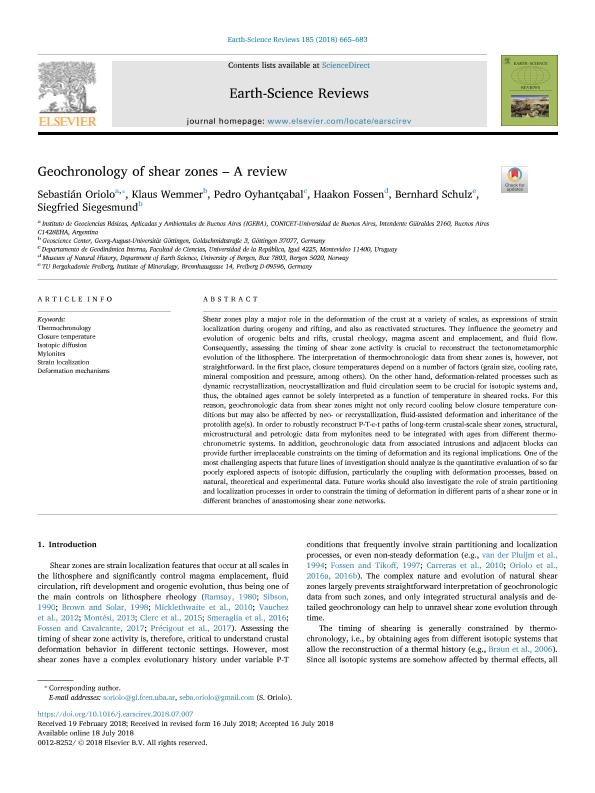Mostrar el registro sencillo del ítem
dc.contributor.author
Oriolo, Sebastián

dc.contributor.author
Wemmer, Klaus

dc.contributor.author
Oyhantçabal, Pedro
dc.contributor.author
Fossen, Haakon
dc.contributor.author
Schulz, Bernhard
dc.contributor.author
Siegesmund, Siegfried

dc.date.available
2019-10-30T19:55:47Z
dc.date.issued
2018-10
dc.identifier.citation
Oriolo, Sebastián; Wemmer, Klaus; Oyhantçabal, Pedro; Fossen, Haakon; Schulz, Bernhard; et al.; Geochronology of shear zones – A review; Elsevier Science; Earth-science Reviews; 185; 10-2018; 665-683
dc.identifier.issn
0012-8252
dc.identifier.uri
http://hdl.handle.net/11336/87703
dc.description.abstract
Shear zones play a major role in the deformation of the crust at a variety of scales, as expressions of strain localization during orogeny and rifting, and also as reactivated structures. They influence the geometry and evolution of orogenic belts and rifts, crustal rheology, magma ascent and emplacement, and fluid flow. Consequently, assessing the timing of shear zone activity is crucial to reconstruct the tectonometamorphic evolution of the lithosphere. The interpretation of thermochronologic data from shear zones is, however, not straightforward. In the first place, closure temperatures depend on a number of factors (grain size, cooling rate, mineral composition and pressure, among others). On the other hand, deformation-related processes such as dynamic recrystallization, neocrystallization and fluid circulation seem to be crucial for isotopic systems and, thus, the obtained ages cannot be solely interpreted as a function of temperature in sheared rocks. For this reason, geochronologic data from shear zones might not only record cooling below closure temperature conditions but may also be affected by neo- or recrystallization, fluid-assisted deformation and inheritance of the protolith age(s). In order to robustly reconstruct P-T-ε-t paths of long-term crustal-scale shear zones, structural, microstructural and petrologic data from mylonites need to be integrated with ages from different thermochronometric systems. In addition, geochronologic data from associated intrusions and adjacent blocks can provide further irreplaceable constraints on the timing of deformation and its regional implications. One of the most challenging aspects that future lines of investigation should analyze is the quantitative evaluation of so far poorly explored aspects of isotopic diffusion, particularly the coupling with deformation processes, based on natural, theoretical and experimental data. Future works should also investigate the role of strain partitioning and localization processes in order to constrain the timing of deformation in different parts of a shear zone or in different branches of anastomosing shear zone networks.
dc.format
application/pdf
dc.language.iso
eng
dc.publisher
Elsevier Science

dc.rights
info:eu-repo/semantics/openAccess
dc.rights.uri
https://creativecommons.org/licenses/by-nc-sa/2.5/ar/
dc.subject
THERMOCHRONOLOGY
dc.subject
CLOSURE TEMPERATURE
dc.subject
ISOTOPIC DIFFUSION
dc.subject
MYLONITES
dc.subject
STRAIN LOCALIZATION
dc.subject
DEFORMATION MECHANISMS
dc.subject.classification
Geología

dc.subject.classification
Ciencias de la Tierra y relacionadas con el Medio Ambiente

dc.subject.classification
CIENCIAS NATURALES Y EXACTAS

dc.title
Geochronology of shear zones – A review
dc.type
info:eu-repo/semantics/article
dc.type
info:ar-repo/semantics/artículo
dc.type
info:eu-repo/semantics/publishedVersion
dc.date.updated
2019-10-15T15:19:51Z
dc.journal.volume
185
dc.journal.pagination
665-683
dc.journal.pais
Países Bajos

dc.journal.ciudad
Amsterdam
dc.description.fil
Fil: Oriolo, Sebastián. Consejo Nacional de Investigaciones Científicas y Técnicas. Oficina de Coordinación Administrativa Ciudad Universitaria. Instituto de Geociencias Básicas, Aplicadas y Ambientales de Buenos Aires. Universidad de Buenos Aires. Facultad de Ciencias Exactas y Naturales. Instituto de Geociencias Básicas, Aplicadas y Ambientales de Buenos Aires; Argentina
dc.description.fil
Fil: Wemmer, Klaus. Universität Göttingen; Alemania
dc.description.fil
Fil: Oyhantçabal, Pedro. Universidad de la República. Instituto de Ciencias Geológicas; Uruguay
dc.description.fil
Fil: Fossen, Haakon. University of Bergen; Noruega
dc.description.fil
Fil: Schulz, Bernhard. Technische Universitat Bergakademie Freiberg; Alemania
dc.description.fil
Fil: Siegesmund, Siegfried. Universität Göttingen; Alemania
dc.journal.title
Earth-science Reviews

dc.relation.alternativeid
info:eu-repo/semantics/altIdentifier/url/https://linkinghub.elsevier.com/retrieve/pii/S0012825218301132
dc.relation.alternativeid
info:eu-repo/semantics/altIdentifier/doi/http://dx.doi.org/10.1016/j.earscirev.2018.07.007
Archivos asociados
